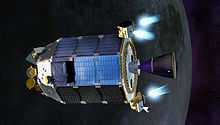Kepler-68c
| Extrasolar planet | List of extrasolar planets | |
|---|---|---|
| Parent star | ||
| Star | Kepler-68 (KOI 246) | |
| Right ascension | (α) | 19h 24m 07.76s |
| Declination | (δ) | +49° 02′ 25″ |
| Apparent magnitude | (mV) | 8.588 |
| Distance | 440 ly (135 pc) | |
| Mass | (m) | 1.079±0.051 M☉ |
| Radius | (r) | 1.243±0.019 R☉ |
| Temperature | (T) | 5793±74 K |
| Metallicity | [Fe/H] | 0.12±0.074 |
| Age | 6.3 ± 1.7 Gyr | |
| Physical characteristics | ||
| Maximum mass | (m sin i) | 7.3 M⊕ |
| Radius | (r) | 0.953 R⊕ |
| Density | (ρ) | 5–40 g cm−3 |
| Temperature | (T) | 944 |
| Orbital elements | ||
| Semimajor axis | (a) | 0.09059 AU |
| Orbital period | (P) | 9.605085 d |
| Inclination | (i) | 86.93 ± 0.41° |
| Discovery information | ||
| Discovery date | 12 February 2013 | |
| Discoverer(s) | ||
| Discovery method | Transit (Kepler Mission) | |
| Discovery status | Confirmed | |
| Other designations | ||
| KOI 246.02
| ||
Kepler-68c is an Earth-sized planet orbiting the star Kepler 68 in the constellation of Cygnus. It was discovered by planetary-transit methods by the Kepler space telescope in February 2013. It has a mass of 4.8+2.5
−3.6 times that of Earth (0.015 MJ)[1] and a radius of 0.953+0.037
−0.042 Earth radii. It has an orbital period of 9.605085 days at a distance of about 0.09059 AU from its star. Relatively wide constraints on Kepler-68c's mass are the result lack of detection of the planet through radial-velocity and transit-timing-variation methods.[2]
See also
- List of planets discovered by the Kepler spacecraft
References
- ↑ Gilliland, Ronald L. "Kepler-68: Three Planets, One With a Density Between That of Earth and Ice Giants". Cornell University. Retrieved 28 February 2013.
- ↑ Nasa. "Kepler Discoveries". Nasa.gov. Retrieved 28 February 2013.
| ||||||||||||||||||||||||||||||||||||||||||||||||||||||||
| ||||||||||
| |||||||||||||||||||||||||||||||||||||||||||
